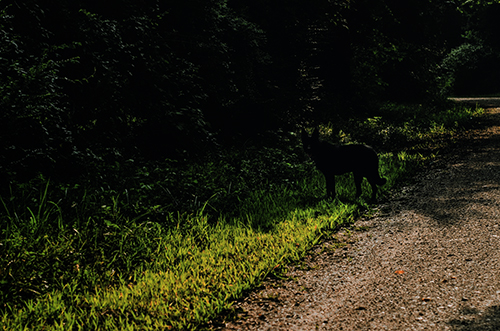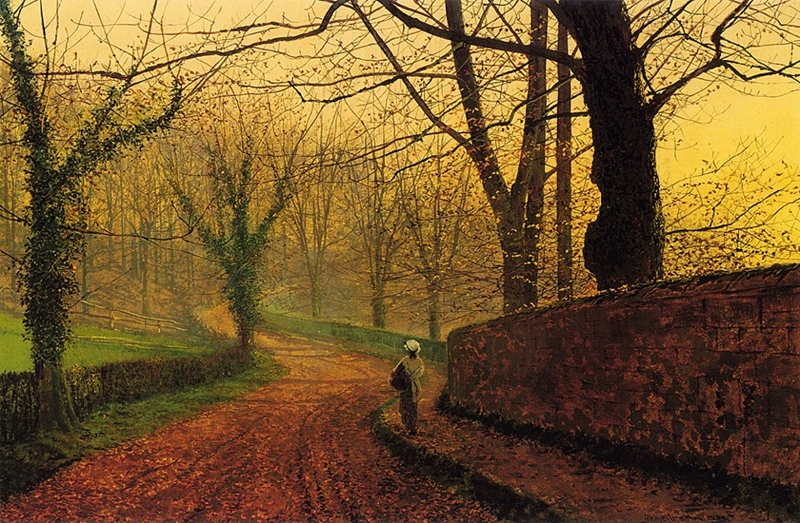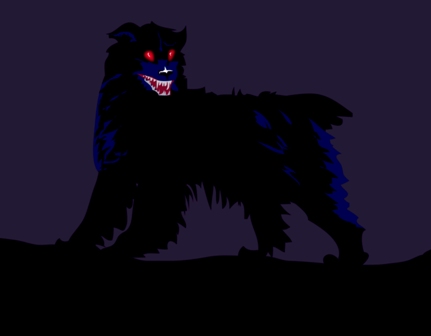The barguest is a fascinating creature, most often found in the folklore of northern England. Folklorist William Henderson noted the barguest tales covered Northumberland, Durham, and Yorkshire (1879: 274). That said, some appearances also crop up in Lancashire and Cumbria.
In many tales, the barguest was most popularly a death omen. In a most fitting way, Sir Walter Scott thought the name came from ‘bahrgeist’, or spirit of the bier, as in the bier on which a corpse was carried (Henderson 1879: 275).
We’ve covered the barguest before in passing when we looked at black dogs. But in this post, we’re going to look at them as an aspect of fairy lore since there’s a lot of dispute about what barguests actually are.
Keep reading or hit ‘play’ below to hear the podcast episode.
What is a barguest?
What the barguest actually is appears to be a source of contention. Katharine Briggs describes the barguest as a bogey-beast, assigning horns, claws, teeth, and fiery eyes to it (1976: 16). Henderson lists it among the ‘local sprites’ of his folklore compendium.
As we’ve already covered, they were often considered a death omen.
One Barguest in particular haunted a piece of wasteland between Wreghorn and Headingly Hill near Leeds, above a spring called the Oxwells. If anyone important died in the area, the Barguest appeared and took the form of a large black dog with huge flaming eyes. It led a procession of all the dogs in the area through the neighbourhood. The Barguest struck anyone that got in their way, and any Barguest-inflicted wound never healed. Henderson relates that a man from Yorkshire told him about the Barguest having seen the procession as a child. Apparently, the procession happened before the death of the local squire (1879: 275).

It’s also something of a shapeshifter. A barguest apparently haunted the area near Darlington that shifted forms between a black dog, a white cat or rabbit, a headless woman, and a headless man who disappeared in a flash of flame (Henderson 1879: 275). It’s unclear how people knew all of these forms were the same barguest.
Where does the name come from?
Rev. William Carr gives two definitions of the name in his glossary of a Yorkshire dialect (1828: 23). Spelled both as ‘barghest’ and ‘bar-guest’, Carr describes it as “a sprite that haunts towns and populated places” (1828: 23). He considers it a Belgian word, from ‘berg’ and ‘geest’, or ghost.
William Hone disagreed that it meant a spirit of towns or populated places. In his reasoning, ‘berg’ means ‘hill’ (it’s actually ‘mountain’), so the barguest becomes a sprite that frequents hills and small villages (1838: 656). He also theorised it came from ‘bär’, the German word for ‘bear’. Apparently, this explained why the spirit took the form of either a bear or large dog (though I can’t find any accounts that involve bears). Hone also takes his evidence from the fact the Craven region has a village called Barden, which he translates as ‘The Bear’s Den’. To him, this means bears were common in the area in earlier times (1838: 656).

Hone also refers to the creature as a spectral hound, probably through the derivation of ‘geist’ (or ghost) to ‘guest’ (1838: 656).
Yet it’s interesting that both Carr and Henderson classify the barguest as a sprite, which puts them into the realm of fairies. Encyclopedia Britannica describes it as a “goblin dog” (2018). Indeed, Briggs including the barguest in her encyclopaedia of fairies demonstrates just how slippery the category can be.
And then we check the newspapers…
Someone wrote to the Teesdale Mercury to explain the meaning of the name (Observer 1857: 1). As much as they repeated the same explanations we’ve already covered, they also noted that in Northumberland, people used the name ‘the brag’. Further, they suggested ‘burg-geist’ as a meaning of ‘spirit of the town or village’, following Carr’s suggestion.
To them, the barguest fell under the ‘sprite’ and ‘demon’ categories, though noted it was “much given to practical joking, though its freaks are usually more mischievous than dangerous”. To me, that places it more in the ‘sprite’ category.
Anthony Whitehead described the barguest in 1901 as “a spirit known only through the sense of hearing”. Apparently it “disturbed the last generations of Westmorland with its awful howling” (1901: 7).

F.H.W. wrote to the Whitby Gazette in 1906 to add an extra explanation. They focused on the ‘bar’ in the name to refer to a gate, as in the bar across a turnpike. That would make sense in its appearances on common highways, though few stories reference turnpike roads (1906: 8).
In the same letters column, Sixty Years’ Resident wrote a letter to add that the barguest was a common story in Whitby some sixty years or so earlier, putting the tales in the early 19th century. Apparently, the barguest was commonly seen in Church Street. It looked like a white pig and seeing it was an omen of death in the family of the person who saw it. It walked along the street and if someone walked on the pavement, it would force them towards the wall. If you walked in the road, it followed you until you reached a lonely part of the road, whereupon it disappeared. No one knew where it went when it vanished (1906: 8).
Over in Lancashire and Cumbria…
T. T. Wilkinson noted meeting witnesses that described the barguest in “the form of a white cow or horse; but on most occasions ‘Trash’ is described as having the appearance of a large dog” (1861: 4). Here, both Trash and Skriker are local names from Burnley bestowed upon the barguest. Wilkinson described the barguest as making a splashing sound while walking, and like the Whitby version, foretold death in the family of the person who saw it. This version was apparently largely invisible, though it uttered dreadful screams when it was invisible—which is presumably how people knew it was there.

If you followed this barguest, it would walk backwards while staring at you, and it vanished if you looked away for even a second. People reported trying to strike it but never making contact with it. Again, Wilkinson refers to the barguest as a sprite (1861: 4).
A letter to a member of the Kendal Natural History and Scientific Society described a barguest in Kendal as appearing as a pig that rattled chains. Another appeared in French Lane, again as a pig, but this time with eyes like saucers. And yet a third wandered around the marketplace. This third one is of most interest as it took “the form of a headless Lady, dressed in white, and having a tankard tied round her waist” (Kendal Mercury 1841: 4).
A Tale of a Barguest Encounter
A man referred to as Billy B related his barguest encounter to Hone (1838: 655). While Hone preserved the Yorkshire dales dialect as it was, I’ve taken the liberty of shortening it and updating it so as to make it more accessible to 21st-century audiences.
Billy had been out drinking at Grassington. He was at pains to relate that he was “far from being drunk”, and he was fully aware of all that went on around him. He left at around 11 pm and noted that it was a beautiful night at the end of the year. The moon was very bright; so bright that he mentioned he’d never seen Rylstone Fell plainer in his life. He heard something pass him. It made a brushing sound, accompanied by rattling chains, though he saw nothing. Billy possessed his wits enough to know something strange was afoot. He paused to look around, but still saw nothing. Crucially, the sound fell silent too. Billy set off once more and the sound resumed. It seemed that the sound stopped whenever he did.

At this point, he realised the creature to be a barguest. He knew they couldn’t cross water so he hurried on towards the wooden bridge ahead of him. He crossed, but the sound continued to accompany him. Billy assured Hone that the barguest either crossed the bridge as well or somehow made a trip of thirty miles around the spring’s head in the blink of an eye. While Billy had felt fear earlier, he suddenly felt a pang of bravery and decided to take a look at the barguest. He tried going up the bank, hearing the sound all the while and still saw nothing. Suddenly, the sound stopped. Billy decided to finally head home. He’d almost reached his door when the sound began again.
He followed the sound, and given the brightness of the moon, he finally saw the barguest’s tail. Happy he’d finally seen it, he decided to go home after all.
Though when he got there, something larger than a sheep sat blocking his door. It would neither get up nor move, so Billy picked up a stick to give it some motivation. It finally looked at him, displaying glowing eyes as big as saucers. He described the eyes as having a series of concentric rings, from red, to blue, to white. It grinned at him but still refused to move, despite Billy’s commands. Eventually, his wife came to the door and the barguest finally got up and wandered off. Billy told Hone the barguest must have been more afraid of his wife than it was of him. He told his wife what had happened, and his wife confirmed it sounded like a barguest. Yet Billy was a lucky man for he never saw the creature again.
And the Padfoot?
Some legends keep the barguest separate from a creature displaying similar behaviour: the Padfoot. Most common around the villages near Leeds, “[h]e is described as about the size of a small donkey, black, with shaggy hair and large eyes like saucers; and he follows people by night, or waylays them in the road which they have to pass” (Henderson 1879: 273).
Rev. J. C. Atkinson of Danby referred to the Padfoot as a death omen (Henderson 1879: 274). Sometimes visible, sometimes invisible, it either padded along behind or beside people. It might utter a roar completely unlike any known animal. Some stories described it as being bigger than a sheep with long smooth hair, which sounds much like Billy B’s description. Yet unlike the barguest, which seems relatively harmless to you personally, Henderson noted the importance of leaving the Padfoot alone. Speaking to it or striking it actually gave it power over you. One man apparently kicked the Padfoot and ended up being dragged through a hedge and a ditch, before being left under his window (Henderson 1879: 274).
Henderson suggests the Padfoot and the barguest is one and the same (1879: 274).
So what do we make of the barguest?
The differences in its descriptions speak in some ways to the fluidity of the categories of ‘fairy’ and ‘ghost’. Calling it a ghost doesn’t fit very well. After all, no one discusses any tragic tales of a dog lost in an accident that would create said spectral hound. Without a live animal preceding the ghost version, it’s perhaps hard to call it a ghost at all.
And yet it probably doesn’t fit with the mental picture that many have of ‘fairies’. That in itself is a loaded term, with the image of fairies altered so much over the centuries. The pranks of the barguest and its often mischievous nature would actually fit more with tales of other types of mischief-loving fairies. Its sudden appearance, marked by sound, and equally sudden disappearance without warning isn’t dissimilar from the Silky. Indeed, its role as a death omen puts it in a similar category as the Bean Nighe or Bean Sidhe. (If you’re interested in the banshee, I have a bonus episode about them available to Patreon supporters!)
So perhaps the term ‘sprite’ fits the barguest best. That way, we can accept its strange behaviour, seemingly with no real end game in mind, without thinking of the tales involving fairies, dangerous bargains, and other matters. Just be sure if you see one to leave it be, and hopefully, it won’t follow you home.
What do you make of the barguest? Let me know if you have any family tales of these creatures in the comments!
References
Briggs, Katharine (1976), A Dictionary of Fairies: Hobgoblins, Brownies, Bogies, and Other Supernatural Creatures, London: Penguin Books.
Britannica, T. Editors of Encyclopaedia (2018), ‘Barghest’, Encyclopedia Britannica, https://www.britannica.com/art/Barghest.
Carr, William (1828), The dialect of Craven, Vol. 1, London: WM. Crofts.
F.H.W. (1906), ‘To the Editor of the “Whitby Gazette”‘, Whitby Gazette, 23 March, p. 8.
Henderson, William (1879), Notes on the folk-lore of the northern counties of England and the borders, London: W. Satchell, Peyton and Co.
Hone, William (1838), The Every-day Book and Table Book, vol. 3, London: Thomas Tegg.
Kendal Mercury (1841), ‘Kendal Natural History and Scientific Society’, Kendal Mercury, 13 March, p. 4.
Observer (1857), ‘The Barguest’, Teesdale Mercury, 21 January, p. 1.
Sixty Years’ Resident (1906), ‘To the Editor of the “Whitby Gazette”‘, Whitby Gazette, 23 March, p. 8.
Whitehead, Anthony (1901), ‘Sairy, Silly Jacky’, Workington Star, 24 May, p. 7.
Wilkinson, T. T. (1861), ‘On the Popular Customs and Superstitions of Lancashire’, Burnley Advertiser, 4 May, p. 4.
Nutty about folklore and want more?
Add your email below and get these posts in your inbox every week.
You'll also get my 5-step guide to protecting your home using folklore!








Have your say!